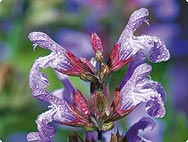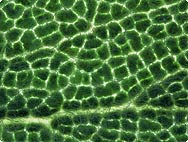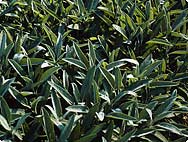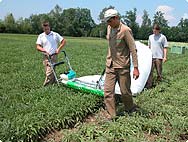A.Vogel search
When the internal search is activated, personal data such as your IP address is transmitted to our search engine Cludo. Data is thus transferred to a third country. Please click here if you want to display the internal search. You can find more information on data protection here: Privacy policy.
A.Vogel plant encyclopaedia
Salvia officinalis L.
Sage
History

It is probable that Sage was used in ancient Egypt to treat stomach ailments, toothache and asthma. It was listed in the Ebers Papyrus (1500 BC) as a remedy for itching. Followers of Hippocrates praised its styptic and strengthening qualities as well as its beneficial effects on menstruation. Under the name of Salvia, the plant was described in the works of the Romans, Plinius, Dioscorides and Galen. They recommended it for warming and contractions, for coughs, hoarseness, for labour pains and ulcers. It is not known which species of Sage was used. The name Salvia comes from the Latin word ‘salvare’ meaning to heal and ‘salvere’ meaning to be healthy. The species name officinalis refers to its use in the medicines of the past; it is derived from the Latin word opificina meaning herb store or pharmacy.
Common Sage appears in both Charlemagne’s “Capitulare de villis” (approx. 790) and that of Ludwig I and was also planted in cloister gardens. Walafrid Strabo (9th century), a monk at the Reichenau cloister in Constance, opened his didactic poem ‘Hortulus’ which explained the healing properties of cultivated garden plants, as follows: “Sage shines forth in the first instance, is pleasing to the taste, is very powerful and also useful as a drink; it has been found to be helpful in most human illnesses and deserves to enjoy a greener youth.”
Sage was to be found in England in earlier times when it was used mainly as a seasoning. Sage was also highly valued in the Middle Ages. The verse “Salvia salvatrix, naturae conciliatrix” – “Sage, thou healer, mediator with nature” – originated from the highly respected Medical School in Salerno.
In 1555 Hieronymus Bock wrote: “Of all the bushes, there is scarcely a bush like Sage, as it can be used in medicine, for culinary purposes, cellars, for the rich and poor. Sage wine, or the herb boiled in wine, eases pain in the sides (= enlarged spleen), warms the liver and womb, quickens the senses and aids female illnesses (=menstruation). It helps with colds and flu and rheumatism, not drunk on its own but also by rubbing it into the limbs. A concoction of Sage can be used for dysentery and to clean out the intestines. Sage boiled in water cleans and heals wounds and bites, helps poisonous bites, staunches bloodflow and cleans foul ulcers, heals scabs. Rubbing teeth with fresh Sage leaves keeps them firm and clean. Sage boiled in wine and used as a gargle soothes sore throats and gullets.”
In 1688 Paullini from Augsburg wrote a 414 page comprehensive monograph on Sage.
Strong smelling plants were often used for the purposes of ritual and for protective purposes. Sage was considered to be a magical plant of the highest order and is still enjoyed by smokers even today. In addition to common sage, Salvia divinorum which is considered as sacred particularly in Mexico, and which has hallucinogenic qualities, is used for this purpose.
Botanical characteristics

Common Sage is a bush, 1 to 80 cm in height with upright stems and numerous side branches covered in downy hairs. The lower parts of the bush are woody. The aromatic leaves are simple, egg shaped or long and narrow and become narrower in the direction of the stem where they are sometimes auriculated. The leaf edge is delicately toothed. The leaves are greenish to silver grey. On the upper side the young leaves are downy hairs and the older leaves are mostly wrinkled and hairless. The downside is always downy haired. The bright blue to typically bluish purple flowers, with lipped corollas, form 6 to 10 whorls with 6 to 10 flowers, 4 to 8 of which are arranged alternatively one upon the other on the main shoots.
The species Salvia is one of the most abundant in the Lamiaceae family and is made up of over 500 species. As well as Salvia officinalis there are various subspecies and numerous cultured varieties. Both subspecies of Salvia officinalis L., ssp. minor (GMELIN) GAMS and ssp. major (Garsault) GAMS provide the Sage leaves referred to in medical books and for the production of Dalmatian Sage oil.
Sage flowers from May to July.
Habitat

As with many labiates, Sage belongs originally to the flora of Mediterranean countries. It can be found in huge numbers from the Dalmatian mainland (Croatia and Montenegro) to the sunny lime hillsides. In former Yugoslavia, the export of Sage leaves and Sage oil represented a considerable source of revenue. It is cultivated there as well as in Albania, Hungary, Germany and France.
Spanish sage, Salvia off. ssp. lavandulifolia, whose volatile oil has a strong eucalyptus smell, comes mainly from Spain. Carnosol acids and bitter substances are not present in Spanish Sage.
Preparation

Bioforce cultivates Common Sage organically. Processed are the leaves. During harvesting, the content of volatile oil is at its highest between 12 pm and 4.00 pm. However this varies considerably according to the conditions of the area in which it is grown.
The freshly cut leaves are cut shortly after harvesting and macerated in alcohol to produce a mother tincture. Tablets are produced by concentrating the mother tincture in a vacuum and with the addition of excipients.
